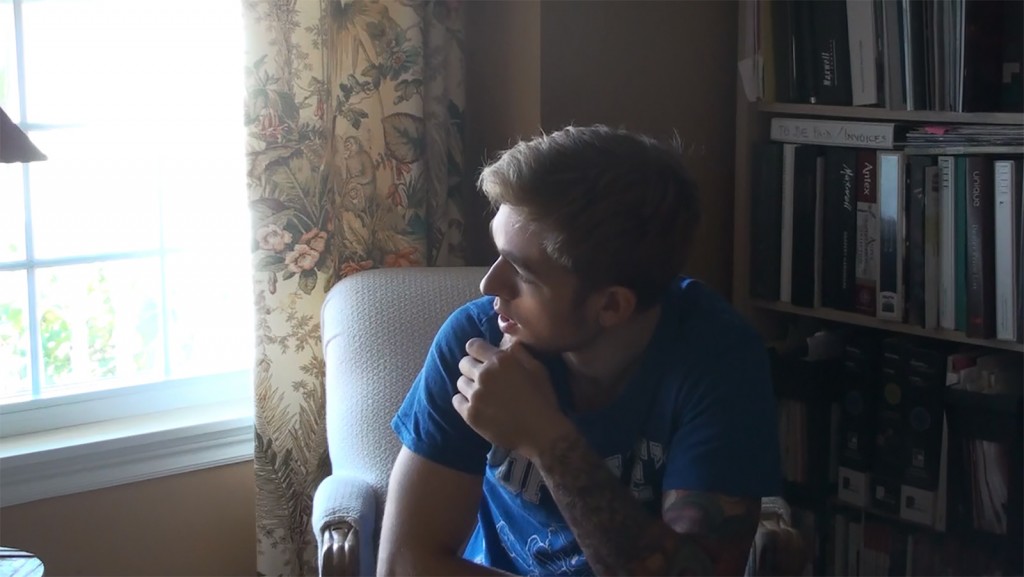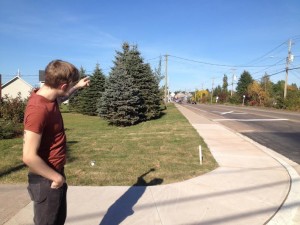Justin Bourque: Hidden behind a paywall

caption
Ryan Taylor was in the lockdown area during the Moncton shooting. He, along with 70,000 other Moncton residents, needed updated information to stay safe.Should removing a paywall be mandatory during times of crisis?
Journalism is constantly being questioned – especially by journalists.
The public doesn’t want to pay for news any more. A common solution for newspapers and magazines is adding a paywall. It’s an easy concept: put up an online wall that makes readers pay a subscription fee before reading the site’s main content.
You may think paywalls are a simple solution to a costly problem. But paywalls have a grey area. In the case of the high-profile shooting case in Moncton, New Brunswick in June 2014, a paywall created controversy.
When Justin Bourque, a north-end Moncton resident, shot and killed three RCMP officers, the city was the centre of a media frenzy. After Bourque fled the scene on foot through a wooded area, people across Canada were talking about the Moncton manhunt. The hashtag #PrayForMoncton became a trending topic worldwide on Twitter.
The Chronicle Herald, Nova Scotia’s largest newspaper, elected to remove its paywall at 10:15 p.m. on the night of the shooting. The decision came an hour after New Brunswick RCMP imposed a lockdown on Moncton. This allowed those not subscribed to the Herald to access the website’s content for free. The Times & Transcript, the daily newspaper serving Greater Moncton and southeastern New Brunswick, did not remove its paywall.
There are two types of paywalls: hard and soft. A hard paywall does not allow any free content without the reader paying a subscription fee, while a soft paywall allows a specific amount of free content. Paywalls are becoming a standard way to increase revenue declining due to the loss of and advertising and circulation revenue.
Brunswick News, which owns the Times & Transcript and is privately run by the Irving family, implements a hard paywall. Readers have to pay a monthly $.99 subscription fee to view any of the website’s content.
When the Moncton paper did not temporarily remove its paywall, residents on lockdown and journalists took to Facebook and Twitter to voice their opinion on Brunswick News’s decision.
Brunswick News owns all but one of New Brunswick’s English and French newspapers. The company took a lot of flack for its decision, but kept its paywall intact. Brunswick News ombudswoman Patricia Graham released a blog post through the company’s newspapers a week after the shooting, explaining why the company made its decision. It was later, with Graham’s permission, republished in J-Source, so the decision could be accessed by those not subscribed to Brunswick News.
Graham recognized the argument that journalism is a public service. But, she said, in management’s view, Brunswick News’s content “was not a catastrophic necessity” and “public safety issues were being adequately handled via social media through Brunswick News journalists.” Graham also said Moncton residents were “free to find (free content) elsewhere.”
I reached out to Graham, offering her an opportunity to further explain the company’s decision. Graham declined, writing in an email she had “nothing to add” to her blog post. I referred her to Brunswick News President James D. Irving’s ombudswoman appointment notice from October of 2013, where he said Graham would be “accessible and accountable to … readers and audience.” She did not reply.
Two days later I called Patrick Brethour, the Editor-in-Chief of Brunswick News. When I told him I was calling to discuss the paywall decision, he asked if I had previously spoken to Graham. When I said yes, he referred me to Graham’s previous comment and said, “We’re going to leave our answer at that.”
This leaves several questions unanswered. Is it a publication’s responsibility to remove its paywall during a crisis? Should residents be willing to pay $.99 to access information being provided by journalists risking their lives? And why would Brunswick News’s ombudswoman refuse to be interviewed about her company’s controversial decision?
Locked down, but not out
The sun cast its last light of the day on north-end Moncton. A balmy late spring breeze swept across the city. Charles Doucet’s son played outside with Heidi, Charles’ wife. Their daughter sat inside watching cartoons. It was a typical Wednesday evening in the Doucet household.
Charles, an avid social media user, pulled out his phone and checked Facebook.
Suddenly, sedate domesticity turned to shock. Then panic.

caption
Ryan Taylor points to where the first shots were fired on Hildegard Drive following the Moncton shooting.His emergency instincts kicked in. Charles whispered what he read to Heidi. Their eyes met. No more words needed to be said.
Quickly but calmly, Charles grabbed his children’s hands. The family rushed to the basement. Charles turned off the lights. Heidi closed the blinds. Their eyes fastened to the television set.
And the family, along with the 70,000 other Moncton residents, waited.
Doucet, who lives two blocks from where one of the officers was killed, said Brunswick News made a mistake by not lowering its paywall. He said if the company had done the right thing during the lockdown it would have created so much goodwill that “they would have gained more subscriptions.”
Kyle Brown completed his master’s degree in communications and new media studies, focusing on how newspapers keep up to date with social media. He is now a communications professional and media analyst based in Ottawa. Brown wrote an article for J-Source on Brunswick News’s paywall decision a week after the shooting. He said “it was weird” when Brunswick News kept its paywall up.
“I was a bit dumbfounded,” he said. “Especially once the Chronicle Herald took their paywall down.”
Halifax’s Chronicle Herald operates a soft paywall allowing readers access to 10 free stories a month. Content accessed through Facebook, Twitter or other forms of social media do not count towards the reader’s free stories.
Rick Conrad is the online editor at the Chronicle Herald. He said the decision to remove the paywall the night of the shooting happened because he and assistant online editor Gordie Sutherland were pushing for it. They argued in favour of the newspaper being a public service, saying “it was incumbent upon us as a media outlet to lower our paywall.”
“If there’s an event like that happening and you have information to keep people safe, give it.”
– Troy Merrick, Moncton News 91.9
Conrad said Frank De Palma, the assistant newsroom director at the time, and Shawn Woodford, the director of marketing and development at the Chronicle Herald, had the final say. After hearing Conrad and Sutherland’s pitch, they decided to temporarily suspend the paywall.
This wasn’t the first time a publication has elected to temporarily remove its paywall for public safety purposes. The New York Times removed its paywall during the aftermath of Hurricane Irene in the summer of 2011 and Hurricane Sandy in October of 2012. The Boston Globe removed its paywall in the spring of 2013 following the Boston Marathon bombing. The decision attracted 1.2 million unique readers. The Seattle Times lowered its paywall during the Oso mudslide in March of 2014, just two months before the Moncton shooting.
Troy Merrick was a reporter for Moncton News 91.9 during the manhunt and now lives in Halifax. He believes Brunswick News “was irresponsible” for keeping up its paywall.
“If there’s an event like that happening and you have information to keep people safe,” Merrick said, “give it.”
Paywall alternatives
The Times & Transcript wasn’t Moncton residents’ go-to source for up-to-the-minute information during the lockdown. Some residents on lockdown said they watched newscasts. Others followed Moncton Newschaser, a Facebook page allowing residents to follow police scanners. Many did both.
One thing remained consistent: everyone wanted to be informed.
Twitter and Facebook were the main social media outlets utilized by New Brunswick RCMP to update residents on the manhunt. A Maclean’s study in 2013 showed two of three Canadians use social media. Of active users, 93 per cent use Facebook while 63 per cent use Twitter. This was up six per cent from 2011.
A Pew Research Internet Project showed that in January 2014, 35 per cent of active online adults between the ages of 18-29 were on Twitter. Only five per cent of those aged 65 and above used Twitter.
Ryan Taylor, a 21-year-old Moncton resident, was at the gym when the first shots were fired. Taylor said he “didn’t go a few seconds without checking Twitter” once he made it home safely.
Taylor, a Times & Transcript subscriber, said there were better sources for information than the newspaper during the manhunt. He said while on lockdown, he followed Newschaser and journalist’s personal Twitter accounts. Taylor thinks Brunswick News should have taken down its paywall because not everyone is on Twitter.
“When you have an uncontained, chaotic event,” he said, “a $.99 charge on credit is a little bit inconvenient.”
Fran Steeves, a 91-year-old retired schoolteacher, is among those not on Twitter. Steeves, also a Times & Transcript subscriber, said she watched the news during the lockdown.
“Paywalls?” she said, “I don’t even know how to turn those things on.”
An issue of accessibility
Brunswick News’s hard paywall is uncommon in today’s online news media. When the Times of London began implementing a hard paywall in 2011, it lost 90 per cent of its readership and related advertising revenue. The publication continued to implement the hard paywall, hoping the revenue brought in from new subscribers would outweigh the revenue lost.
Jacques Poitras, who worked as a reporter at the Telegraph-Journal in Saint John for six years, is undecided about whether a hard paywall is right for Brunswick News.
“The jury’s still out on it,” he said. “They’ve taken a risk and other media organizations are watching it to see how it goes.”
In September 2014 Poitras published Irving vs. Irving: Canada’s Feuding Billionaires and the Stories They Won’t Tell. Poitras chronicles the strains within a family empire entering its fourth generation. He explores the Irving newspaper monopoly in New Brunswick and how that province’s press is, or is not, covering the family’s business.
Poitras said the unique circumstance of Brunswick News controlling 33 of 34 of New Brunswick’s print newspapers allows its hard paywall model to succeed. He said other media organizations would likely not find as much success because they “aren’t in the adventitious position in their markets that (Brunswick News) is.”
Brunswick News introduced Patricia Graham as ombudswoman in October of 2013. Graham was the editor-in-chief of the Vancouver Sun and vice-president of digital at Pacific Newsroom Group before working for Brunswick News. Graham is the first person in the company’s history to hold the position.
Brown, who wrote the article on the paywall debate a week after the shooting, said he reached out to Graham to speak on behalf of Brunswick News while writing his J-Source story. He said, “she told me she supported the decision Brunswick News made and to look forward to the blog post where all my questions would be answered.”
“Hiring (Graham) was an acknowledgement that they still had to make an effort to demonstrate good faith,” he said.
Poitras acknowledged that Graham doesn’t have an obligation to comment past the blog post, and her columns could easily be considered her reports to the audience. But he said that’s “kind of disappointing.”
“She is there to be as transparent as possible,” he said. “And explain these decisions to the public.
“It’s unfortunate to me that she wouldn’t do that.”
History of Canadian paywalls
Editor's Note
This story was reported and written by Oct. 17, 2014.

